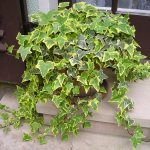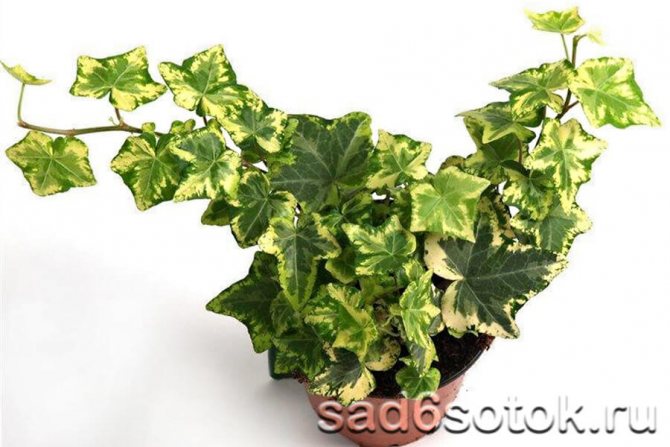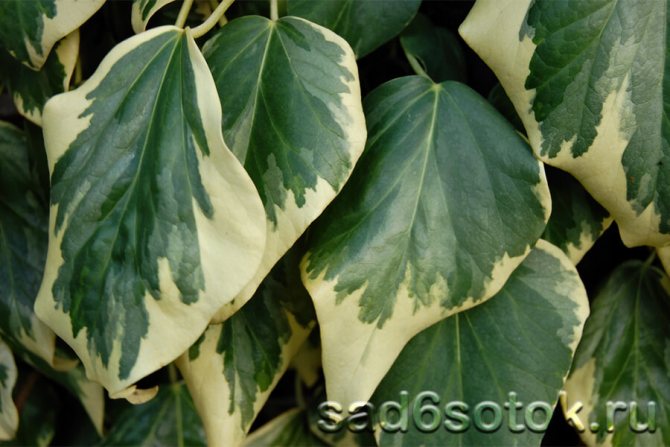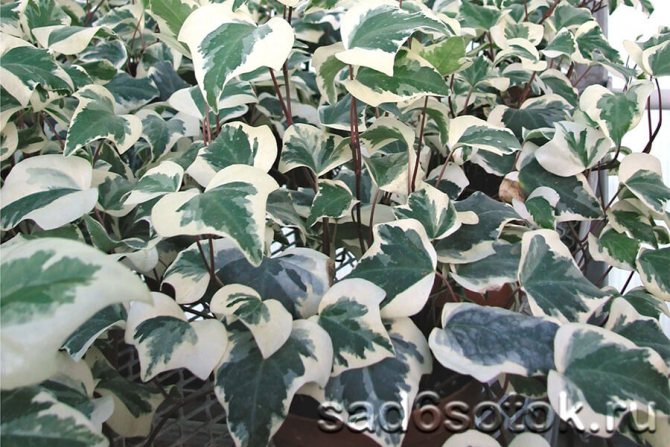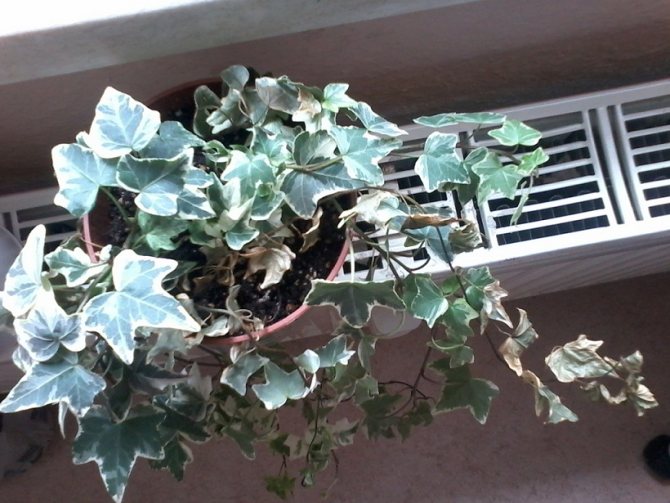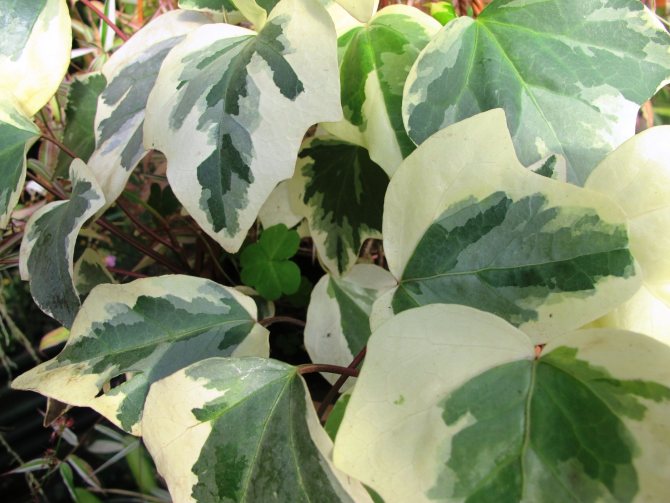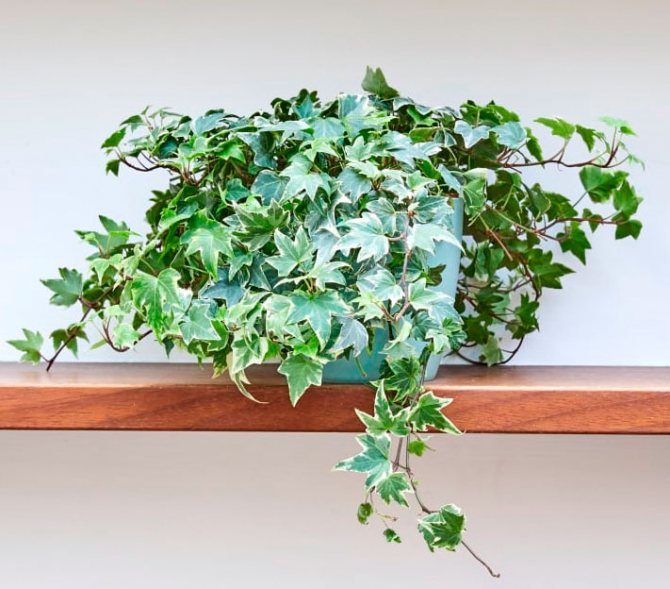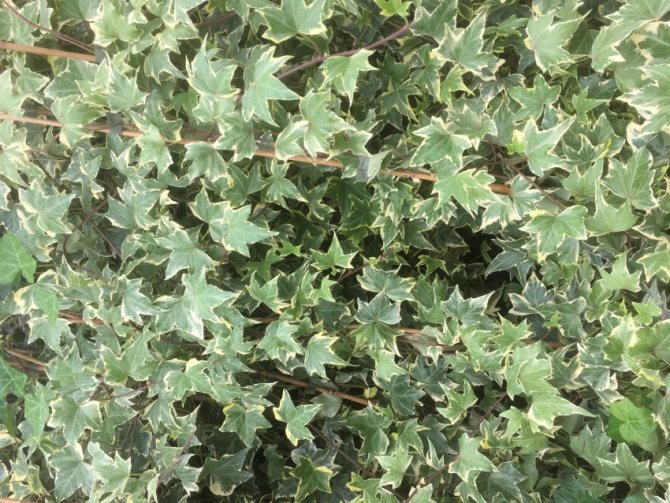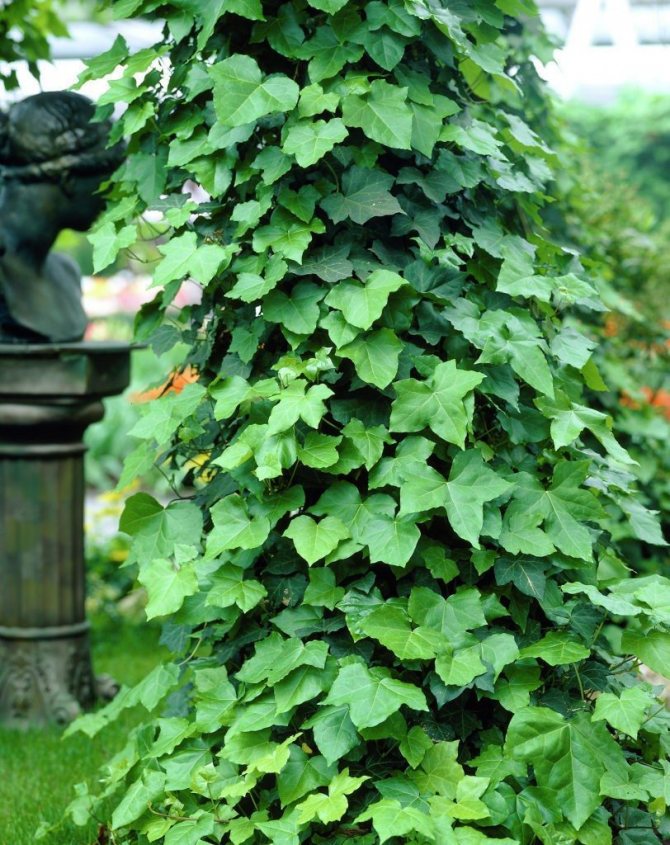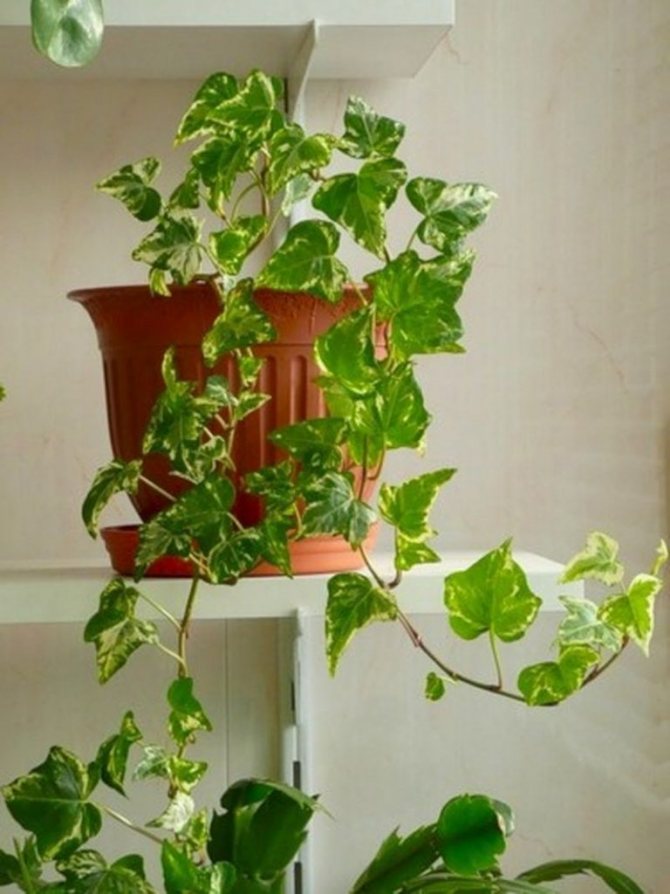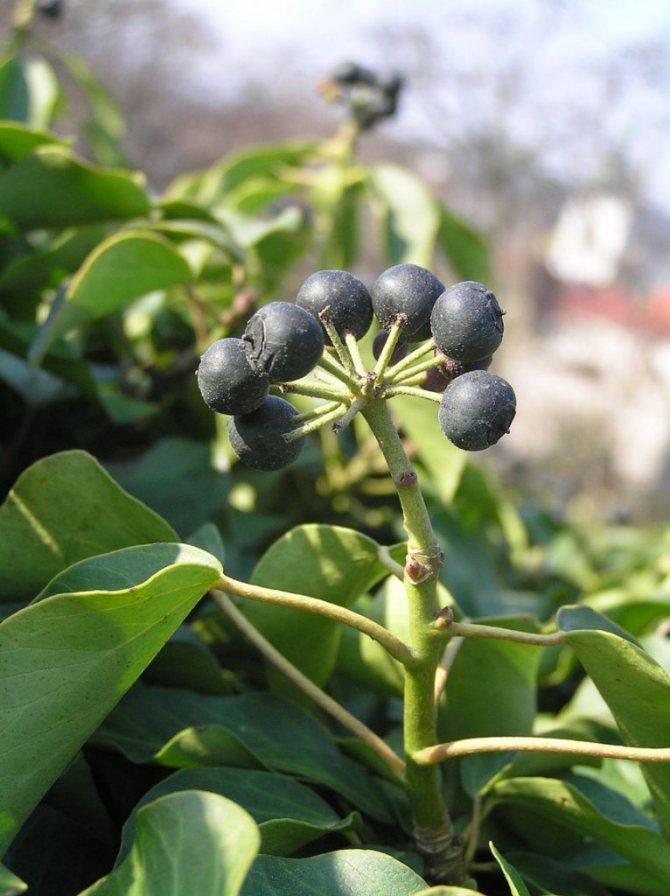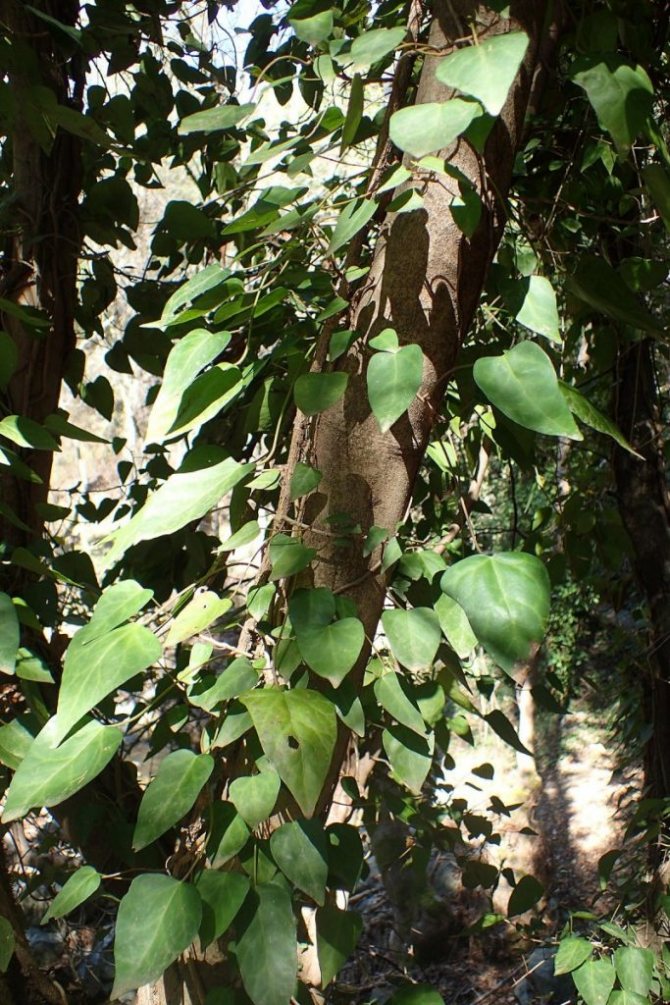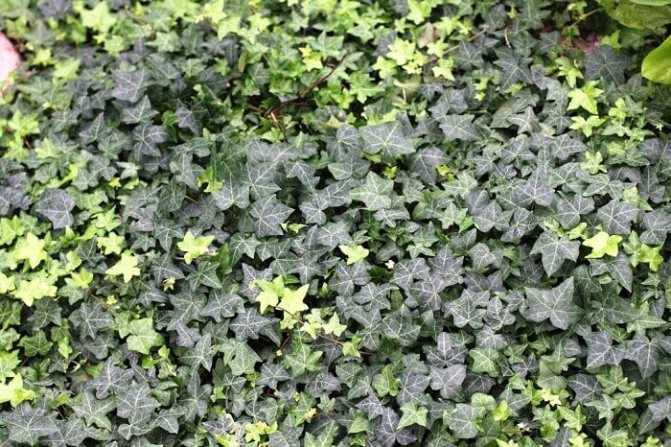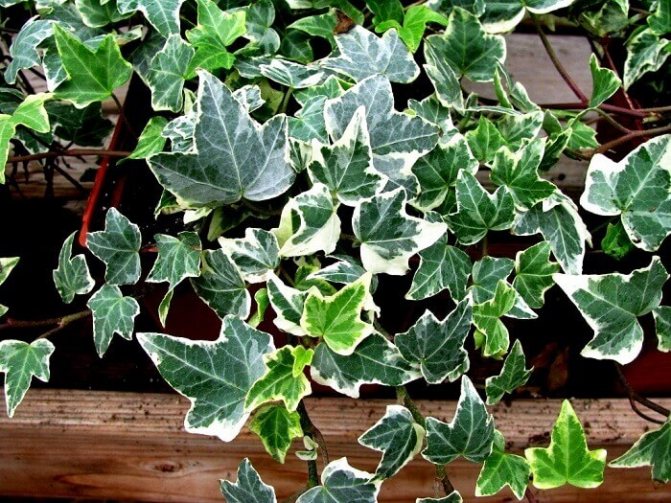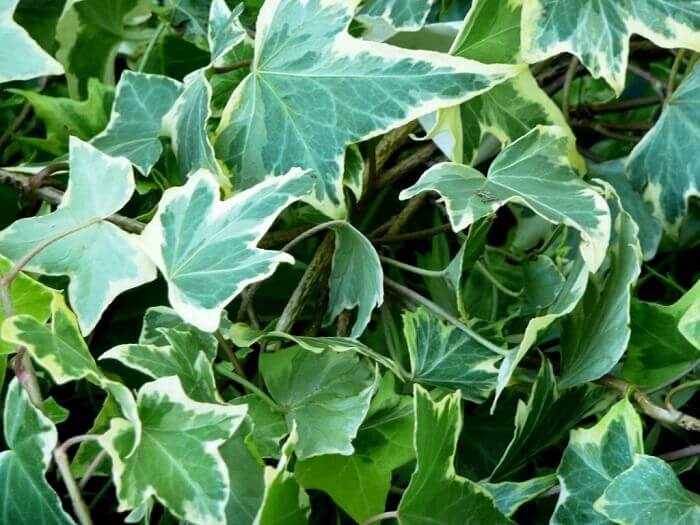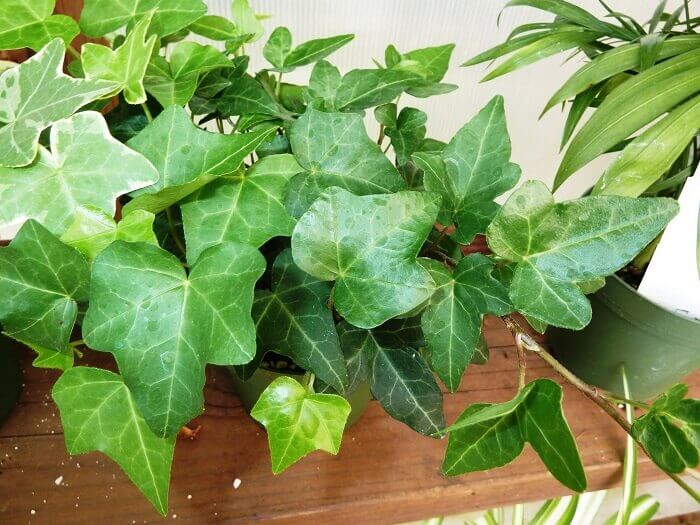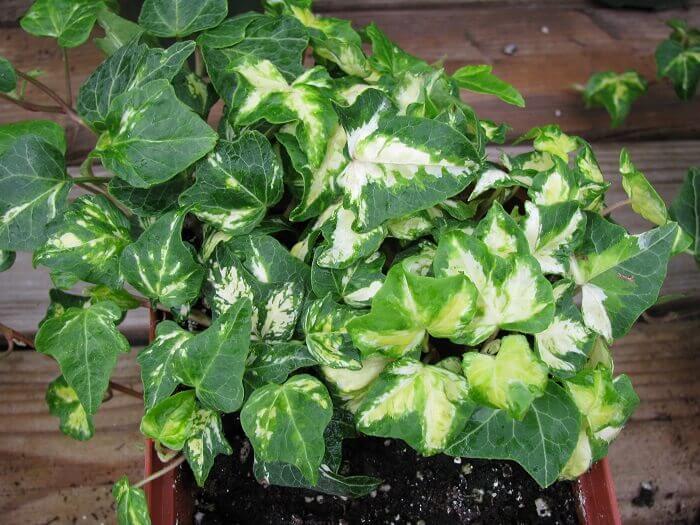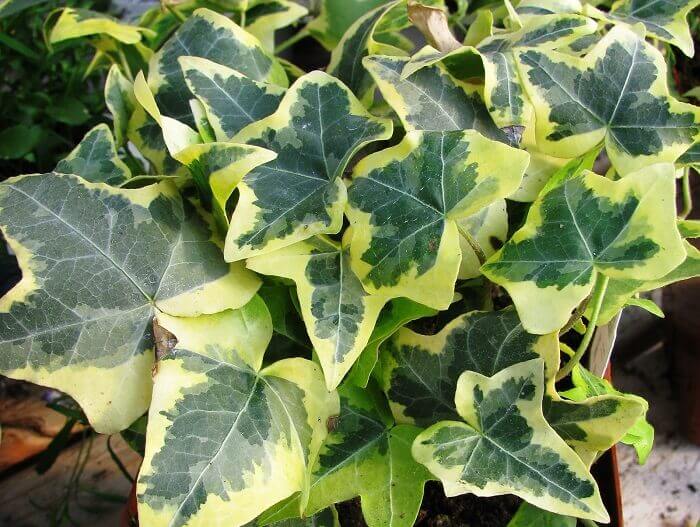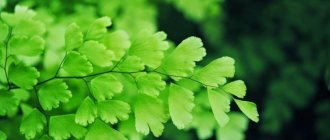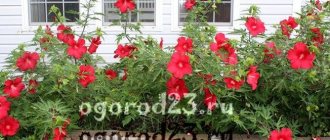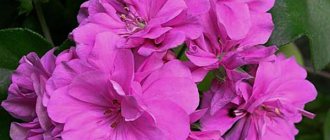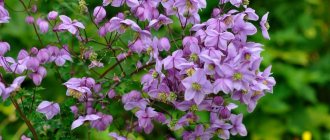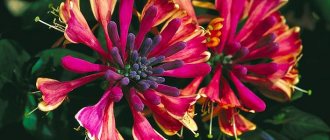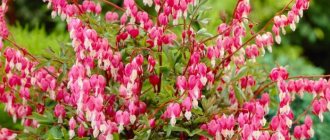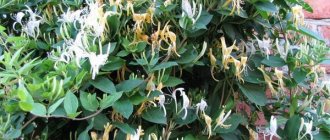Ivy or hedera (Hedera) belongs to the Araliev family. The genus includes about 15 species of evergreen long-lived climbing vines. There are known specimens that are 700 years old!
The Latin name "Hedera" most likely comes from the Greek word "hedra" - attachment, indicating a characteristic feature of the culture to quickly attach to the support with the help of numerous aerial roots located on the underside of the shoots.
The longevity of the plant is due to its low soil and climatic requirements, as well as unpretentious care.
Indoor ivy in home gardening is represented mainly by two species Hedera canariensis and Hedera helix and their numerous varieties, hybrids and varieties that differ in leaf shape, size and color.
Content
- Listen to the article
- Description
- Ivy - can I keep it at home? Properties
- Ivy - signs
- How to care
- Propagation by apical cuttings
- Common ivy (Hedera helix)
Ivy myths

Signs and superstitions about indoor ivy have always been present in our life.
Stories about ivy have been written since the days of the Ancient World, when:
- among the Greeks, ivy was a symbol of fun;
- among the ancient Romans, the plant symbolized fidelity, love and marriage;
- the peoples of the East believed that the flower nourishes the owner with vital energy.
Nowadays, a superstition with a negative color has appeared, claiming that ivy is an energy vampire and a muzhegon that attracts loneliness. So, indoor ivy is a spectacular ornamental plant that is widely used for vertical gardening of indoor interiors and requires minimal maintenance.
Planting and caring for ivy
- Bloom: decorative deciduous plant.
- Lighting: for forms with green leaves - partial shade or shade, for variegated - bright diffused light or light partial shade.
- Temperature: during the growing season - 22-24 ˚C, in winter coolness is needed, but not lower than 13 ˚C.
- Watering: regular, moderate.
- Air humidity: increased. The plant needs daily spraying, and if kept in a warm room in winter, the pot should be kept on a pallet with wet pebbles.
- Top dressing: from March to August twice a month with complex fertilizers for decorative deciduous plants.
- Rest period: in winter.
- Transfer: young plants are transplanted annually, adults - as needed, when the pot becomes small.
- Reproduction: mainly vegetative: layering, shoots, apical cuttings.
- Pests: aphids, scale insects, false scales, cyclamen and spider mites, mealybugs, greenhouse thrips.
- Diseases: loss of decorativeness due to poor care and improper maintenance.
Read more about growing ivy below.
Care
Watering
Ivy does not tolerate excess moisture well. The frequency of watering depends on the season and the air temperature in the room.
In summer, the plant is watered often and abundantly, the soil should remain loose and slightly damp. In winter, it is moistened moderately, not allowing the soil to dry out from the inside, but from above the soil may be slightly dry.
The optimal irrigation regime in warm weather is 1-2 times a week, in winter - 1 time in 10-12 days. It is important not to allow waterlogging to avoid the appearance of rot. Water for irrigation should be at room temperature and settled, without precipitation and impurities.
In addition to spraying, ivy loves bathing in the shower. Leaves are wiped from dust with a damp cloth or sponge.
Top dressing
Complex mineral fertilizers for decorative deciduous plants are suitable for feeding ivy. From organic fertilizers use mullein infusion (1: 5).
From March to October, the plants are fed once every 10-14 days. In winter, fertilize once a month or take a break in feeding.
Bloom
At home, ivy rarely blooms. Flower buds are laid on the tops of 10- or 12-year-old plants. It takes a lot of light to form them.
Ivy flowers are small, white or pale pink in color with an unpleasant odor. The flowers have rounded petals and a bright center. They are collected in umbellate inflorescences. The fruits are dark blue, poisonous, so you should not leave them.
Transfer
Young ivy is transplanted 2 times a year, adult plants - 1 time a year. The transplant is carried out during the period of active growth - in the middle of spring. Several plants can be planted in one pot. In this case, the flower arrangement will be more magnificent.
For transplantation, prepare the ground, expanded clay or pebbles for drainage and a new pot 2-3 cm in diameter larger than the old one. Before being removed from the ground, the ivy is well watered so that the earthy clod is saturated with water and the root system is not damaged.
Drainage is placed on the bottom of the pot, part of the soil is poured and moistened. The ivy is carefully removed from the old pot along with an earthen lump on the roots and planted in a new pot. The rest of the soil is poured around the plant, compacting it.
When transplanting, make sure that the root collar is not buried, but at the same time it does not rise much. It should be at ground level. After transplanting, the ivy is watered and temporarily removed to a shaded place.
Formation
Scheduled pruning of ivy is carried out during the period of active growth. Old and diseased shoots are removed to the very base. Pinching the top of the shoots promotes branching.
Ivy can be formed into a tree by grafting on Japanese fatsia. Both of these plants belong to the same Araliaceae family.
In fatsia, lateral shoots are removed and the stem is tied to a support. After its growth to a height of 1 m, cut off the top, cut the base crosswise to a depth of 2.5 cm. Then insert 3-4 ivy cuttings with the ends cut obliquely into the cuts. The cuttings are secured with a rope or twine. As a result of such a formation, a beautiful tree with falling branches will turn out.
Indoor ivy - description
The houseplant ivy is most often Hedera helix, with a climbing stem and dense brushes of aerial roots on the underside of the stem that attach the Hedera ivy to its support. The leaves of this species are alternate, simple, shiny, leathery, lobed, dark green in color with lighter veins, but there are also variegated forms. An ivy leaf can have three to seven lobes. Small, greenish-yellow flowers are collected in umbellate, corymbose or racemose inflorescences, but you will not see them - ivy does not bloom at home, so you do not have to collect ivy seeds.
Indoor ivy flower has more than a hundred forms, which differ in size, shape of leaves and their colors.
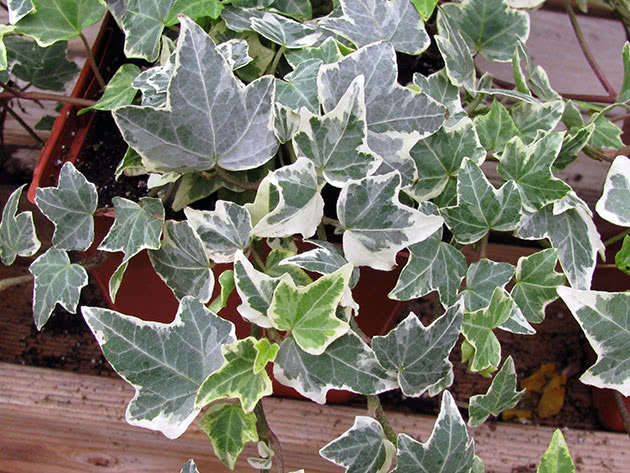

General information


Common ivy is a climbing evergreen shrub of the Araliev family.
Its natural growing environment is humid subtropical regions of Asia, Africa and Europe.
There the plant can reach a length of 30 meters, sometimes in gardens too. The size of indoor ivy, of course, is more modest, but in the variety of species the flower will not yield to its natural "brother" - there are more than a hundred forms that differ in color, shape of leaves, and sizes.
At all times, the attention of man has been riveted to ivy: sometimes it was extolled, as in Ancient Greece, considering it a symbol of love, or it was feared that, according to signs, ivy could harm a person, attracting troubles and troubles to itself.
The plant has also found application in medicine; medicinal tinctures and other preparations are prepared from it.
Ivy - can I keep at home
Ivy properties
Ivy has long been known to mankind for its healing properties used in folk medicine. Ivy is also used as a raw material for the manufacture of medicinal products and cosmetics. Scientists have proven that the substances contained in the wood of the plant successfully relieve spasms, therefore, wood preparations are used in the treatment of acute bronchitis. And ivy leaves have antifungal, antitumor, antibacterial and expectorant properties. Softening gels made from ivy leaves and wood are used as an additional agent in the treatment of purulent dermatoses, obesity and cellulite.
- Indoor plants - trees
However, be careful, because poison ivy, or rather its fruits, which children mistake for edible berries, cause poisoning.


Ivy - signs
The OBS Agency (one grandmother said) claims that the indoor ivy flower is a muzhegon, an energy vampire, that it attracts loneliness and other misfortunes to the house, and if you do not like this plant, you can convince yourself and others that you do not want to keep ivy at home because you love your husband and take care of your family. But historical documents claim that in the ancient world - Greece and Rome - ivy just symbolized fidelity and happiness in marriage, and in the east it is still considered a source of vital energy. Which signs to believe, choose for yourself.
From myself, I will add that caring for home ivy is so simple, and its decorative qualities are so undeniably high that it would be foolish to refuse to grow ivy in an apartment. In addition, ivy can be kept at home in a place where he will not have time to absorb your energy (if he does it at all) - for example, in the kitchen, where ivy will have to cleanse the air from carcinogens and other harmful impurities day and night.
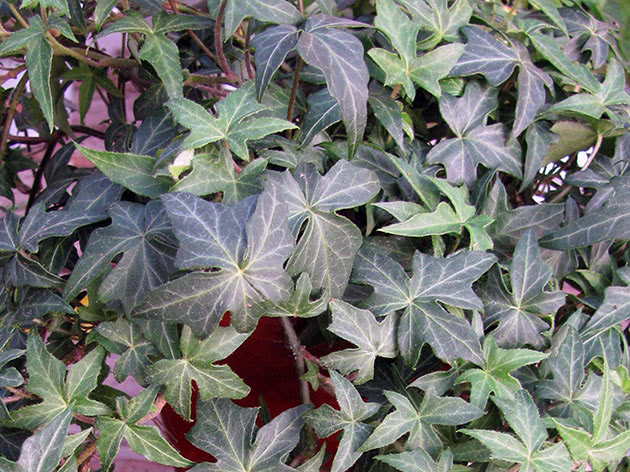

Is it possible to grow a heder at home
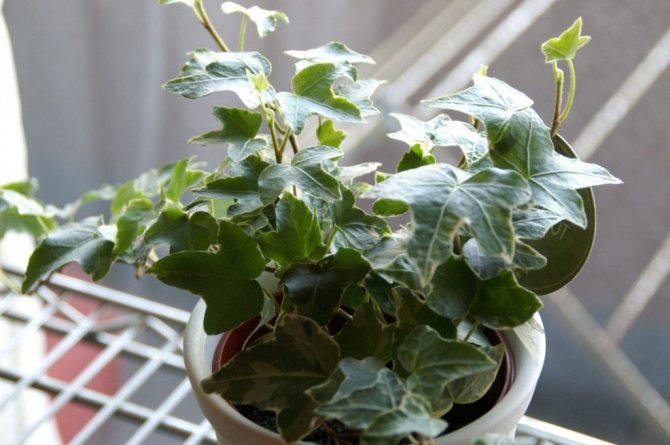

Florists have no unequivocal opinion on the issue of growing liana at home.
Connoisseurs of the shrub are sure that it can be kept at home, since indoor ivy is able to bring to its owner a lot of good... In support of their opinion, they cite such arguments as:
- in a house where ivy grows, mutual understanding and harmony always reigns between all family members;
- the plant absorbs negative energy, helping to reduce conflict situations and, as a result, the number of divorces;
- the flower is able to relieve excessive excitability and have a positive effect on too active children;
- if an unmarried girl becomes the owner of a decorative perennial, then she will marry very quickly and successfully;
- For a married woman, a flower will help save her family from adultery, as well as from the hypocrisy of her spouse.
Opponents of the creeper believe that a houseplant like ivy can only do harm, which is as follows:
- the plant is an energy vampire that uses the positive energy of its owners and transforms it into negative;
- if a woman becomes the mistress of the heder, then the liana pushes all men away from her, not allowing her to find family happiness;
- if the flower is not provided with proper care, then it will attract financial difficulties and large monetary losses to the house, as well as cause illness and depression.
Scientists have not found evidence of either the positive or negative effects of the shrub on their owners, and therefore each grower independently makes a decision about growing indoor ivy.
Ivy care at home
Home ivy care
If you don't know how to care for ivy, heed our recommendations. One of the main advantages of ivy is its shade tolerance, because it is a rather rare quality for plants. Home ivy can be placed in the back of the room and it will feel great there. This, unfortunately, does not apply to variegated forms, which just need good lighting, otherwise their leaves become monotonous green.
Ivy is also undemanding to watering: it is easier for it to transfer dry soil than excess moisture in the roots, so for those who love or have to often leave home, ivy is an ideal plant. However, the plant still needs moisture, and if the bouts of your forgetfulness become too frequent, a brown edge will first appear on the edges of the leaves of the plant, and then they will begin to dry and fall off. Watering should be done in the summer so that the soil always remains slightly moist. In winter, the topsoil should dry out slightly.


Ivy does not like dry and hot air, the best temperature for a plant is 22-24 ºC. In winter, ivy can normally feel in a cool room with a temperature of at least 13 ºC, but the leaves on the stems of plants located near heating devices grow at long intervals, which makes it unattractive, so caring for ivy in such conditions involves not only timely watering , but also daily spraying of leaves with soft, settled water.
- Spring transplant of ficus
When wintering a plant in a hot room, it is best to place the ivy in a pot on a pallet of wet pebbles or expanded clay. If the room is too hot in summer, spray the plant as often as possible, sometimes give it a shower, including for hygienic purposes.
From March to August, ivy is fed twice a month with a complex fertilizer for ornamental deciduous plants, but keep in mind that an excess of fertilizer can lead to a loss of ivy's ornamental qualities, as its leaves become too large.
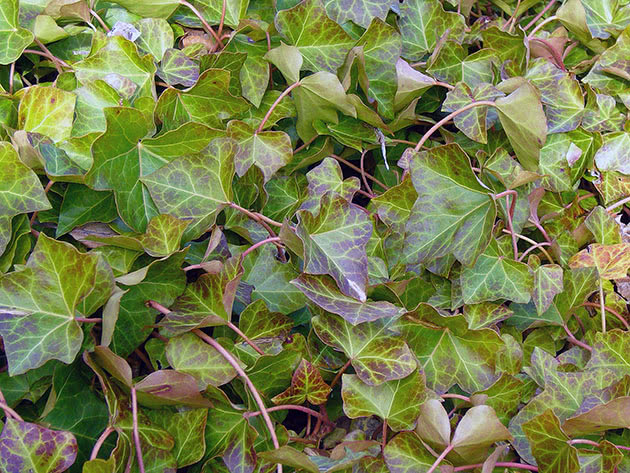

Planting and transplanting ivy
Ivy is transplanted when the roots of the plant begin to creep out of the drain hole of the pot or you notice that the plant has stopped developing. You can, of course, not wait for these hints, just transplant young plants annually, those that are older, once every two years, and in adult ivy they simply change the top layer of the substrate in the pot to a fresh one without transplanting. The soil for ivy is preferable of this composition: humus, leaf, sod, peat soil and sand in equal proportions.
The transplant is carried out after a dormant period, in March or April. The pot is chosen two to three centimeters larger in diameter than the previous one, and a thick layer of drainage material is placed in it. Before transplanting, water the plant abundantly so that the entire earthen lump gets wet, then carefully transfer the plant with the lump into a new pot, add the required amount of soil, flatten the soil surface, leaving a groove for water under the walls of the pot. After transplanting, the plant should be watered and sprayed, and then put in a permanent place, protected from drafts and direct sunlight.
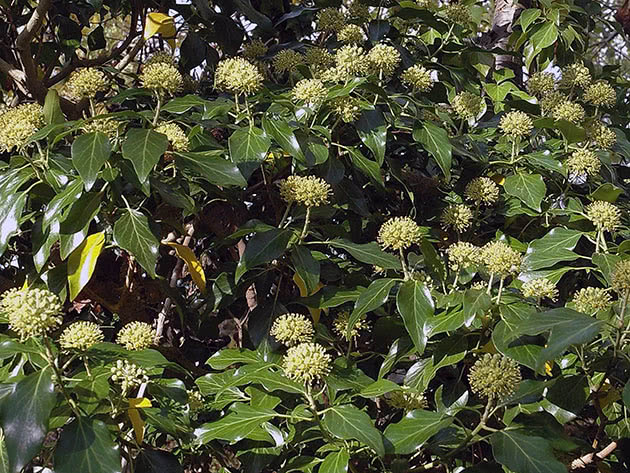

Growing conditions
Lighting
It is widely believed that ivy prefers shady places. In fact, the plant likes good lighting, but not under the hot sun. In shaded places, its shoots are stretched, internodes thicken.
Variegated plants react especially sharply to a lack of lighting. They turn green, losing their unusual coloration.
In summer, when the bright sun is especially active, ivy is protected from direct midday rays. Places with diffused light are chosen for the plant - in the back of the room or on the windows on the west side. In winter, all ivy needs good lighting. Also, the plant does not like frequent rearrangements.
Air humidity
Ivy doesn't like dry air. In winter, when the heating is on in the room, the air around is humidified from a spray bottle or the pots are placed in trays with wet pebbles or expanded clay.
In the summer they are sprayed more often. In warm weather, the plant is taken out into the street, balcony, placing the pots in a light shade. With the arrival of autumn, they are brought into the room, but they regularly ventilate the room.
Temperature
The optimum air temperature for summer keeping is 20–25 ° C. In winter, moderate - in the range of 12-14 ° C.
The soil
Ready-made universal earth mixtures or prepared independently from equal parts of turf, leafy soil, sand and peat are suitable for the plant. Perlite is added to the store-bought soil to ensure looseness and moisture permeability.
Ivy is undemanding to the acidity of the soil, it develops equally well both in slightly acidic soil and in a slightly alkaline substrate. When planting a plant, good drainage is required.
Reproduction of ivy at home
Ivy propagation is carried out by vegetative methods: cuttings, shoots and layering.
Ivy propagation by apical cuttings
The ends of shoots about ten centimeters long are cut off from ivy, planted in a mixture of sand with deciduous soil, covered with a transparent cap - a plastic bag or glass jar - and kept at a temperature of 15-20 ºC, keeping the soil moist, but not wet. It is best to root those cuttings on which there were aerial roots before planting. Cuttings that have taken root are transplanted into pots with a soil mixture for adult ivy, several pieces. Ivy cuttings root well in water.


Ivy propagation by shoots
There is a way to grow multiple shoots from one. To do this, cut off a whole ivy shoot with eight to ten leaves, make a longitudinal incision along it, lay the shoot on the sand with an incision down and press it to a depth of 1.5-2 cm, leaving the leaves above the ground. During germination, care must be taken to keep the soil moist. Within two weeks, roots should form along the entire length of the shoot, as evidenced by the growing tip of the shoot. The shoot is removed from the sand, cut into pieces with roots and at least one leaf, and planted three in one pot with a diameter of 7-9 cm.
- Katarantus: growing from seeds at home and in the garden
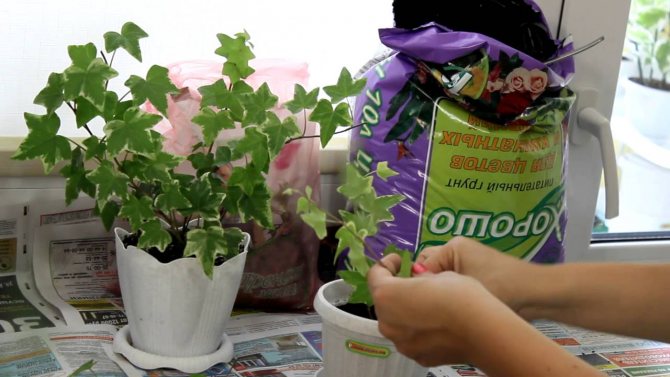

Ivy propagation by layering
How to grow ivy from a cut? In the same way as from the shoot, only in this case the shoot is not separated from the mother plant before the start of the process and is not pressed into the soil, but a longitudinal incision is made on it and pressed to the soil surface with staples. The layering is separated when roots appear throughout the shoot, and transplanted into a separate pot.


Ivy on the balcony


This plant perfectly decorates the balcony.
It is most convenient to place it in a hanging basket.
So that the water after irrigation does not flow down, the bottom of the basket is covered with a reliable film, I pour a layer of drainage on it, and only then - nutritious soil.
The basket should be placed on the balcony so that the plant is not "at gunpoint" by direct sunlight.
For the winter, such structures are usually brought into the house so that the plant does not die, because even a glazed balcony will not save the “subtropical guest” from freezing temperatures. The ivy whips are pre-wound and laid on the ground so that in such a compact form the plant is in anticipation of warm spring days.
Ivy pests and diseases
Ivy is a plant that is quite resistant to disease. He only gets into trouble if you chronically neglect the conditions for growing the plant.So, with a lack of lighting, variegated forms of ivy lose their variegation and become green, and chronically dry soil can cause leaf fall, just as too dry indoor air can cause bald stems with sparse and small foliage.
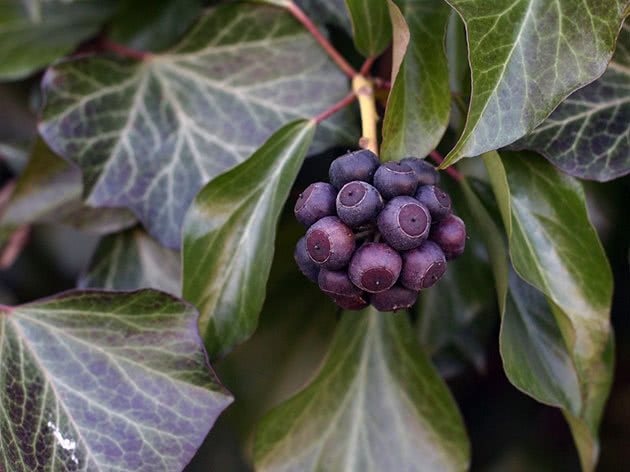

Due to your oversight, ivy is also affected by harmful insects - aphids, scale insects, cyclamen or spider mites. Usually they all appear on the plant if the room humidity is too low. You can fight these parasites by carefully spraying the plant with actellik solution at the rate of 1-2 ml of the drug per liter of water. In addition to actellik, karbofos and aktara show good results in the fight against the above pests.
If after the first spraying you could not achieve success, repeat the procedure after 3-4 days. If this is not enough, instead of spraying, rinse all the foliage in a basin with an insecticide solution.
Plant properties
Traditional medicine actively uses recipes based on this plant. Tinctures and teas made from it help to calm coughs. And as strong as whooping cough. And for the treatment of the eyes, the leaves of the flower are soaked at night, and in the morning they are washed with this water. In ancient times, they tried to treat blindness in this way, but they did not succeed.


The ancient Romans believed that ivy was able to give eternal beauty and youth, so they pinned a twig to the dress at chest level.
With the help of ivy, they wondered about the betrothed. A man who wants to see the face of his beloved in a dream must pick ten leaves. Throw one away and put the rest under the pillow.
And when there is a bride, fortune-telling allows you to test the strength of feelings and loyalty to the chosen one. For this, questions are asked to the wonderful vision of the beloved, and in the morning, remembering the dream, a decision is made.
But today, signs of ivy have changed their meaning and relevance. Those who grew it, after reading this article, are unlikely to get rid of their pet. But people contemplating buying a young escape will doubt this step. Remember, superstition is only a small part of our life and cannot completely determine the future.
Types and varieties of ivy
We bring to your attention the most popular types and varieties of ivy in room culture.
Common ivy (Hedera helix)
Flexible, creeping evergreen vine with alternate simple three to five-lobed leathery dark green leaves with a network of light green veins. Has a huge number of forms. The most interesting varieties:
- Kholibra - dwarf ivy with tiny three-lobed leaves with a whitish pattern;
- Eva varieties and Mona lisa - ivy with almost yellow leaves;
- varieties Jubilee, Glacier - ivy with spotted leaves;
- Ivalace grade - ivy with corrugated leaves;
- Harald variety - ivy with oval, almost rounded leaves.
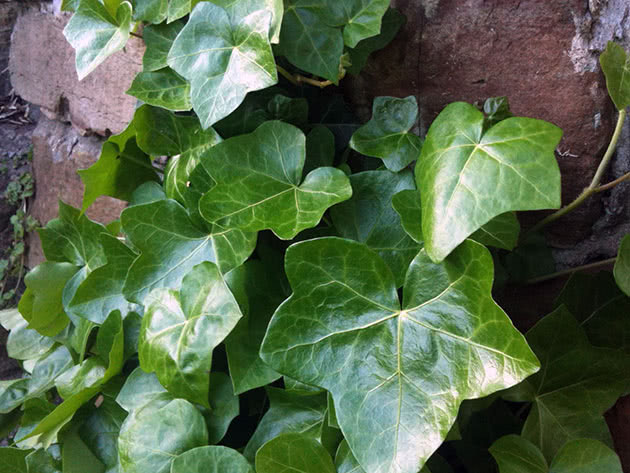

Colchis ivy (Hedera colchica)
Also an evergreen climbing plant with thin shoots, large shiny leathery leaves of dark green color up to 25 cm long and up to 17 cm wide, sometimes three-lobed, but more often whole, smelling of nutmeg. Popular varieties:
- Dentata Variegata - variety with oval-shaped leaves and pale yellow edges;
- Sulfur Heart - the large leaves of this variety are light green in color, slightly curled upside down, and yellow-green stripes run along the veins;
- Arborescens - light green drooping shoots and oval leaves.
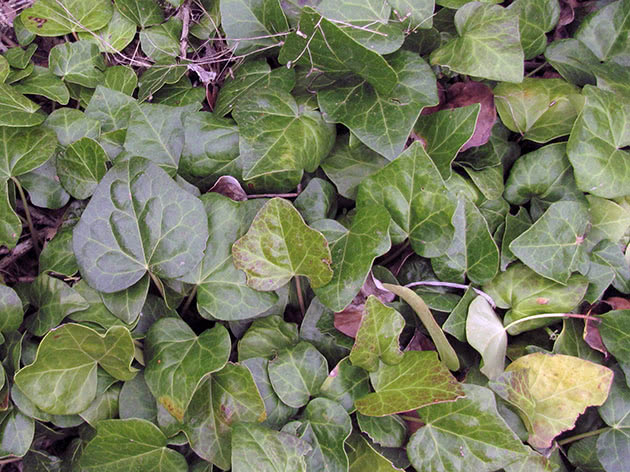

Canary ivy (Hedera canariensis)
An evergreen climbing plant with dark green leaves up to 15 cm wide and up to 12 cm long with light green triangular veins. It is used for interior decoration, ampel, ground cover and vertical gardening. It has no aerial roots, so it needs strong support and regular pruning. Varieties:
- Gloire de marengo - a large climbing plant with reddish stems and large three-lobed shiny leaves with whitish-green strokes along the edges;
- Striata - variety with light - green or yellow - spots in the middle of the leaves;
- Gold leaf - two-colored green leaves cast gold in strong light;
- Brigitte - a variety with small, dense star-shaped leaves on graceful shoots - looks best in suspended structures.
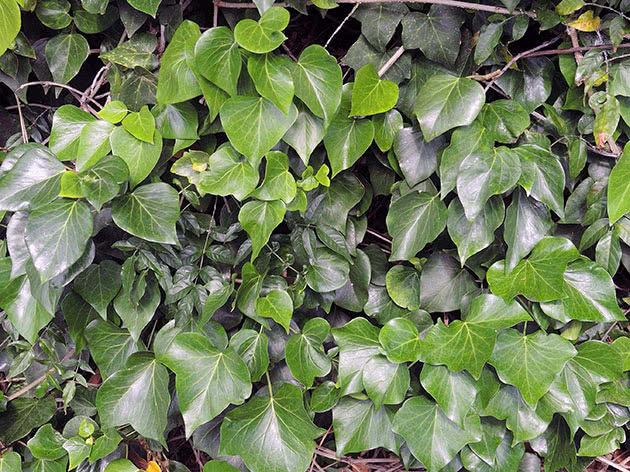

Popular heder varieties
- Buttercup - leaves are pinnate, a small part of them are pure yellow;
- White Night - white leaves with a rich green edging look unusual and attractive;
- Eve - the exact opposite of the "White Night" variety: green foliage with white edging;
- Glacier - differs in silvery specks on green foliage with white edging;
- Lace - evenly colored saturated green lobed three-toed leaves;
- Mint hummingbird - on green foliage - specks of a yellowish-cream shade;
- Ivy Luzia - light green foliage with dark green spots;
- Perkeo - rounded leaves.
Precautions
Hedera is very poisonous. Its fruits, which look like greenish umbrellas, are especially dangerous. When ingested in their pure form, they cause serious poisoning. Therefore, the plant should be kept where children and pets cannot reach it.


Important! Do not let your pets eat indoor ivy leaves: this is very likely to be fatal.


It is better to take care of the plant by wearing rubber gloves. Particularly sensitive skin can become covered with an allergic rash if you trim the cheder or cut off the stem from it with your bare hands.
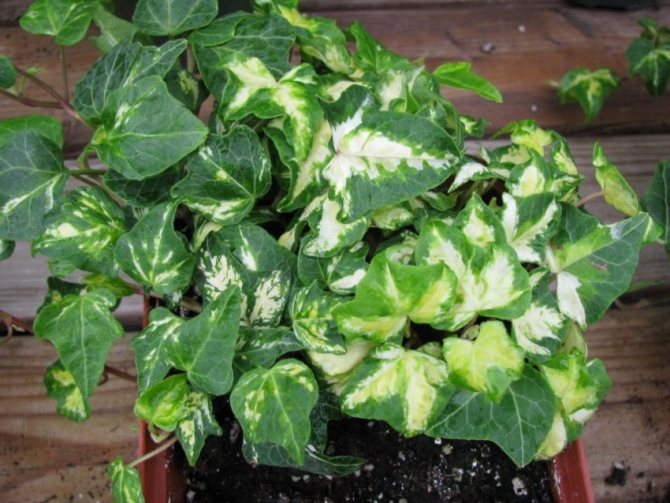

Distribution in nature
In nature, araliaceae grow in shady forests, under the crowns of trees, on rocks, they often spread along the ground, so they are not demanding on light. The aerial roots of the plant are adapted to hold on to any support, be it a tree or a rock. This allows him to climb to a height of about 30 meters. The air roots also help in getting additional nutrition.
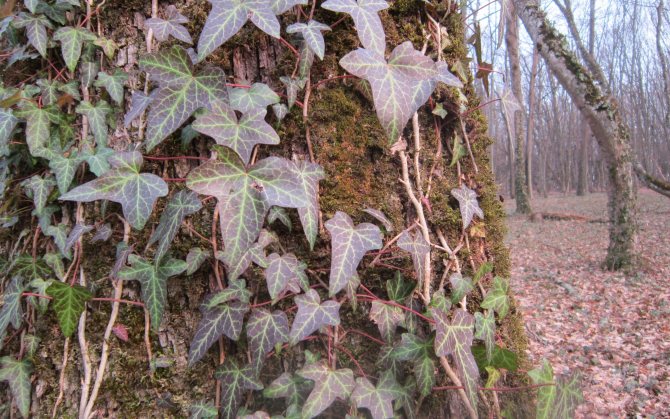

How to get rid of ivy
Often, gardeners are faced with the problem of filling the territory with a hedera. It grows extremely quickly, and can completely cover the entire garden and vegetable garden. To avoid this, it is recommended to cut the vine at the very base, to completely dig out the root system. It is important to remove the shoots in order to prevent them from further rooting. When young growth appears, it is worth using herbicides. This is the only way to bring it out.
Attention! The culture has many varieties, some of which are poisonous. But the flower itself and its leaves are not dangerous. The danger is represented by inflorescences and berries.
The indoor plant can be grown safely indoors or in the garden. You can create a real decorative miracle. Garden compositions are simply amazing. You just need inspiration and a little grooming.
Pruning and shaping
To form a beautiful bush, the heder needs to be pruned periodically. The optimal time for pruning is mid-spring. Remove all bare shoots that have lost their decorative effect. Too long lashes are shortened by a third or half. The length of all shoots after pruning should be approximately the same.
The bush is formed in the form of an ampelous plant or a climbing vine. In the first case, the heder is planted in hanging pots, the length of the lashes is adjusted by cutting. In the second case, the ropes are pulled, special supports or decorative lattices are used. When grown in the form of a climbing liana, they immediately find an optimal, permanent place - it will not be possible to remove the plant from the supports without damage.
Photo
You can admire indoor ivy grown at home in the photo:
Transplant and feeding
For ivy, it is best to use loose and light soil. Experienced growers can make the following mixture:
- 2 pieces of leafy land;
- 2 parts of sod land;
- 1 part sand.
The ivy container should be wide, not deep. It is necessary to replant the plant every spring, and young fast-growing ivies - twice a year.
For old plants, replacing the topsoil will suffice.And also, if the roots have grown through the drainage hole, it's time to transplant ivy.
Particular role in ivy prosperity good drainage plays - at the bottom of the pot there should be a layer of expanded clay 2 - 3 cm high. It is important not to forget to make large drainage holes in the pot.
However, ivy can thrive when grown. using hydroponics.
Application in medicine
The healing properties of chedera were known back in the Middle Ages, they are described in detail by Leonardo Da Vinci. Modern medicine turned to the Aralievs relatively recently, only now the pharmaceutical industry has begun to produce preparations made from ivy. The plant contains substances that have bactericidal, antifungal properties and have an anti-inflammatory effect. Medicines made from the extract of this evergreen plant are used in the treatment of the lungs, gastrointestinal tract, liver and pancreas.
Little tricks
Ivy is an excellent decorative material, it can also be used to create unusual compositions, here is one of them. If you take a plant from the same family, for example "Fatsia" and graft several hedera shoots on it, then after a while you will get an unusual willow-like tree.
Related entries:
- Beloperone with bright feather flowers seems to have come from the fictional world of Red, yellow, the iridescent flowers of Beloperone growing indoors will attract so much attention that you will start it even a little ...
- Climbing indoor (house) plants, called lianas Admit it, because each of you probably at least once saw simple flowers with long, descending or growing along stretched threads, branches? ...
- Cardamom - an unusual spice for growing at home Growing an overseas spice on your windowsill? It couldn't be easier! Content1 Description of the plant2 Where it grows3 Species4 Use5 Useful properties and ...
- Indoor plant Fittonia. Mix of contrasting colors. Red streaks on the green surface of the leaf, you see, look interesting. There is a feeling that blood is flowing through them, and not plant sap ... ...
- Beautiful and mysterious. Hoya or Wax Ivy. Oh, these balls are pink, white, variegated, symmetrical and not very beautiful and desirable. Contents1 Description2 Types of climbing plants ...
Garden ivy in landscaping
Usually in landscape design, common ivy is used in the garden as a small, fast-growing liana, however, it looks great as a ground cover plant. With the help of inconspicuous roots, the plant clings to flat, rough surfaces and is able to climb to any height. For example, after installing a wooden trellis, periodically twist the lattice strips with twigs, as a result you will get an ornament of green leafy cells and rhombuses. The entwined arches and wicker canopies are an elegant garden decor.
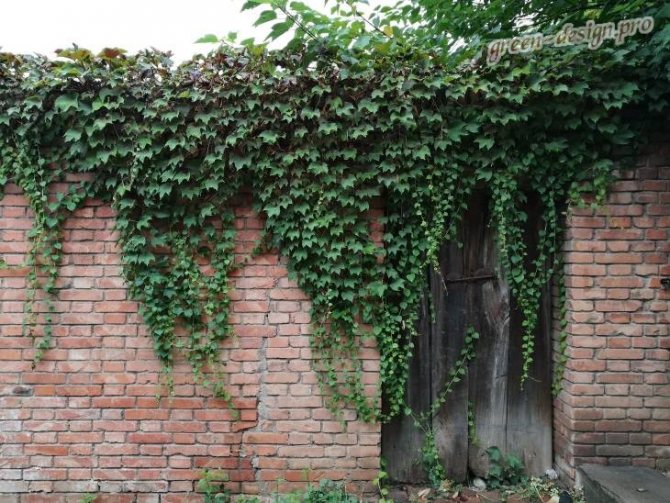

The formation of amazing living frames by a circle of windows and doors is considered quite popular, they imitate the framing of passages in the wall, thus creating an optical illusion. Using liana as a ground cover culture, it can be used to hide communications, for example, next to a fountain or a pond, disguising communications and other unpresentable elements under lush greenery. The plant looks great in pots on elevations or in stone vessels. Some species with small curly leaves, such as "Minima", wonderfully decorate mini-flower beds or borders. Filigree luscious greenery can decorate potted gardens, window sills, balconies and terraces. With the help of vines, sculptures of the most unusual shapes are formed and serve as an alternative to sheared shrubs.
Possible problems
Even considering that the hedera is absolutely not a capricious plant, growing it, growers may face little problems.
If the ivy leaves turn yellow, the plant is short of water. If the leaves do fall off, then the air for the plant is excessively dry.
These troubles can be avoided by using enough water and by spraying the leaves.
If the ivy does not have enough light, then the green leaves begin to fade. This problem is solved by transplanting or transferring a pot with a plant to a sufficiently lit place.

